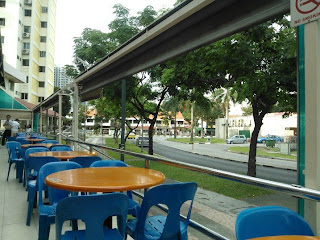Left Foot Braking...WRC and me
WRC Rally Sweden, Feburary 2012
Probably it is my inclination towards long distance running as opposed to track and field. While my motorsport enlightening began with F1, the World Rally Championship (WRC) began to be more appealing to me as I grown older.
Rugged, tough conditions, endurance, not to mention immediate danger, come to mind when you talk about WRC racing. Unlike the sterlie environment of F1, where the drivers have helpers and chaperones following them every moment of the race. WRC drivers drives dirty cars, changes their own tyres, roll their own cars back on its wheels when they overturn.
The money I am not too sure, but I figured F1 drivers should earn more due to more endorsements.
As a driver, I am more of a tarmac person. In Singapore, there are few offroad tracks in Singapore. My experience of offroading was limited to my infantryman days riding shotgun in an Mercedes GD290 jeep in different countries. An excellent offroader, I must say, but easily turned topsy turvy.
My ride, the trusty Nissan March, though with motorsport heritage, belonged firmly on tarmac. Its suspension is hopeless even on portholes road.
I had to acquire a rally driving tactic at one point in time to aid me in driving. That tactic is left foot braking. Back in 2009, I told my right ankle ligament. That put me off driving for one month. It was a double edge sword, when one is on crutches, one needed the car more than ever. But I was not able to drive. Getting off at the wrong bus stop and faced with a 300m walk to the correct one, left me in tears as I limped on my crutches.
After not driving for more than a month, I got back in the driver seat. I realised while my right ankle was able to modulate the throttle and brakes, I feared I may not have the strength to perform an emergency braking if circumstances needed. That made me unconfident to drive. Hence, I began to learn the technique of left foot braking.
It was difficult at first as the left ankle is not used to gently modulate brakes. The practices results in me driving like a novice driver. Jerky braking and high fuel consumption. Not to mention aching calf muscles. Overtime, it became part of my driving and I could drive with the same confidence I had prior to my injury.
I realised that there were advantages to driving with left foot braking. First, you will be first off the line in a traffic light as you will on the accelerator a split second faster than anyone else. Second would be the weight transfer control of the car during braking and hard acceleration. With braking, the car will lurch to the front causing the the rear to feel light and have less traction.
This is not an issue in straight line braking, but potentially dangerous when hard braking in a bend. Hard on the brakes, turning the steering wheel, and a brief tap of the throttle restored some weight and traction on the rear. Oversteer (tail swinging) is reduced.
The exact opposite happens in hard acceleration into a corner. A brief tap on the brakes while accelerating hard in a corner transfers some weight onto the front wheel and increases its traction. The reduces understeer.
Note: In 90 percent of driving, you should not be hard braking or hard accelerating. The above instructions is to be used only if you are proficient in left foot braking and you are caught in an unexpected high speed corner. In most instance, a sensible speed should be used when driving in bends and cornering.
I got lazy and adopted to usual driving arrangement (right foot for throttle and brakes), after my ankle has recovered. However, from time to time, I still used left foot braking when I want to drive Marchie sportily or when the need for speed arises.



Comments
Post a Comment